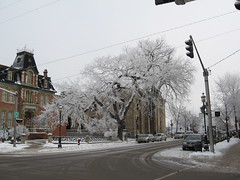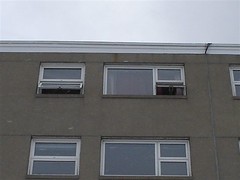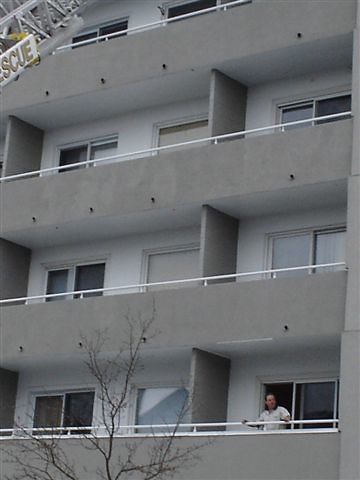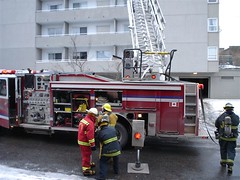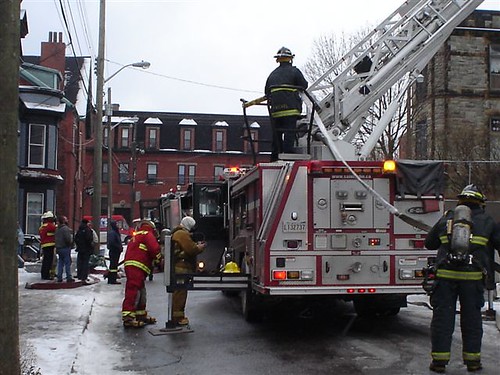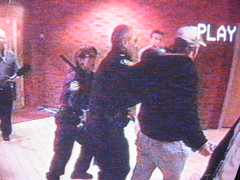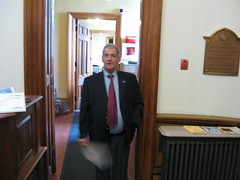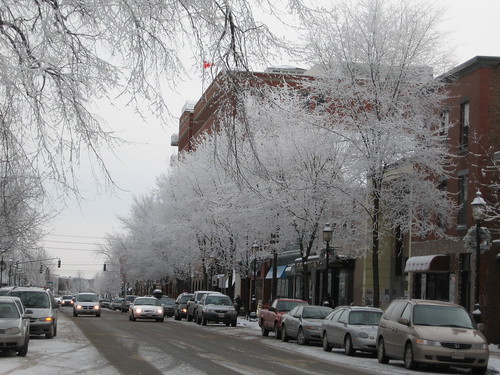
Wednesday, December 06, 2006
Fire at 7 floor building in South Saint John on Mecklenburg Street!!! < By Tim Smith >
Judge Wlliam.J. McCarroll < in his own words >
New Brunswick >> Provincial Court >>
This document: 2006 NBPC 37 (CanLII)
Citation: R. v. LeBlanc, 2006 NBPC 37 (CanLII)
Date: 2006-11-24
Docket: 05571102
[Noteup] [Cited Decisions and Legislation]
Citation #2006NBPC37
IN THE PROVINCIAL COURT OF NEW BRUNSWICK
JUDICIAL DISTRICT OF SAINT JOHN
Date: November 24th, 2006 Docket: 05571102
Between:
Her Majesty The Queen
- and –
Charles Joseph LeBlanc
Before: Judge William McCarroll
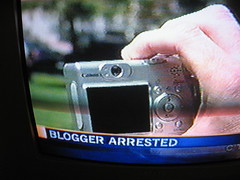
Date of Hearing: November 2nd, 20th, 21st, 2006
Date of Decision: November 24th, 2006
Appearances:
Catherine McNally - Agent for the Crown
Harold Doherty - Agent for the Defendant
McCARROLL, Prov. Ct. J.
Police work is difficult on the best of days. June 9th, 2006 was not a good day. To say that all hell broke loose for a few terrifying moments at the Trade and Convention Center on that day would not do justice to the situation. No amount of training could have prepared three of Saint John’s finest, standing at the entrance to the meeting rooms of the Center, for the onslaught of masked and noisy demonstrators racing towards them with sticks and signs, intent on pushing their way through the glass doors to the interior of the conference hall. Only the strength and courage of the three officers who stood up to the onslaught prevented a more serious situation from developing inside the meeting room. These officers are to be commended for their courage and determination.
Caught up in the middle of all of this was the defendant, Charles LeBlanc. There was no evidence whatsoever that he was in any way involved with the group of protestors. Mr. LeBlanc is a “blogger”. I’m sure that many, if not the majority of Saint Johners, are not familiar with this word. This is not surprising, since the word, to my knowledge has not yet found its way into a dictionary. I went to the computer in an attempt to find a definition.
The Google website defines “blogger” as a person who writes weblogs, and a blog as a shortened version of weblog.
I reprinted the following definitions from the Google website:
“Blog is short for weblog. A weblog is a journal (or newsletter) that is frequently updated and intended for general public consumption. Blogs generally represent the personality of the author on the web site.”
“A blog is basically a journal that is available on the web. The activity of updating a blog is “blogging” and someone who keeps a blog is a “blogger”. Blogs are typically updated daily using software that allows people with little or no technical background to update and maintain the blog.”
“A “web log” or online diary. Blogs have been identified as an increasingly popular source of online publication, especially regarding political information, opinion publication and alternative news coverage.”
“A collaborative space either stand alone or within a website that visitors can post comments, link to, add to, or just read on a weekly, daily, hourly basis. Used extensively on journalism sites for breaking news, etc……”
Apparently the defendant is quite well known for his blog. In fact, Sergeant Connell, the police security planner, utilized the information obtained on the defendant’s blog to gather intelligence about the potential for protest during the Atlantica conference. Sergeant Connell did not expect that Mr. LeBlanc would himself cause any problems at the conference.
However, on June 9th, 2006 while Mr. LeBlanc was taking photographs of the demonstration at the Trade and Convention Center, he was arrested for willfully obstructing Sergeant John Parks.

The Facts
On June 9th, 2006, the Saint John Trade and Convention Center played host to the “Atlantica” Conference. Delegates were in attendance from the Atlantic Provinces and the New England States.
Because of the nature of the business being discussed, organizers feared the arrival of protestors, and took precautions to prevent a breach of the peace. Two police officers were assigned to attend at the Convention Center on each day of the meetings. These officers received their orders directly from senior police officers within the Saint John Police Department, and were at all times acting in the capacity of on duty officers, whose main assignment was to keep the peace, protect the public and property.
On June 9th, 2006 Sergeant John Parks and Constable Tanya Lawlor arrived at the Center at 7:00 a.m. They took up positions in the area of the glass doors leading into the meeting room.
Organizers of the conference had taken great pains to ensure that the expected protestors would not disrupt proceedings. The foyer of the Center had been cordoned off on both sides with metal posts and drapery. Entry to the meeting room was to be through a rather narrow space between the two cordoned off areas. It was made clear to delegates that name tags were required at all times in order to gain entry to the meeting room. Even paid up delegates were turned away if they were not in possession of their name tags. The hallway entrance to the washrooms was behind the cordoned off area, so that only delegates with name tags could access the washrooms.
On the far end of the hallway leading to the washrooms was the business office of the Center. An emergency door was at the end of this hallway. It was locked from inside, leaving the only entrance point to the meeting room the space between the cordoned off areas.
Between 12:30 and 1:00 p.m. on June 9th, a younger looking man wearing a name tag came from inside the meeting room, and headed down the hallway in the direction of the washrooms. Within minutes there was a howling mass of masked and unmasked young people running through the same hallway toward the glass doors of the Center. They were yelling, banging things, carrying signs and were clearly intent on gaining access to the meeting room.
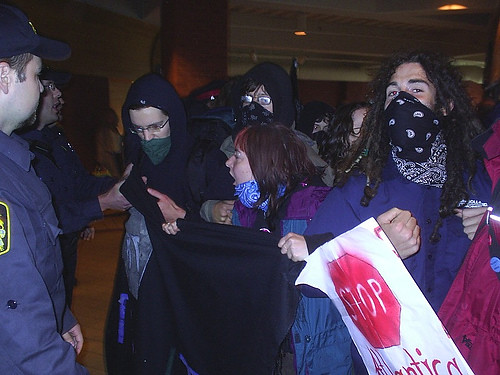
Only 3 police officers stood between this howling mass of humanity and the glass doors into the Center. The third officer, Constable Cooper had only arrived seconds before to see if either Sergeant Parks or Constable Lawlor wanted to take a short break. It was fortunate that he was there.
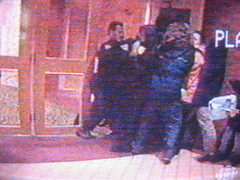
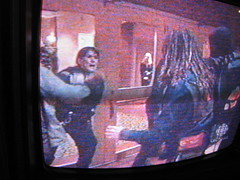
As the mob approached the cordoned off area, the poles and draperies quickly came crashing to the floor…..now there was no cordoned off area. Many of the female organizers of the event ran into the rooms and locked the doors…..they were terrified…..but who wouldn’t have been.
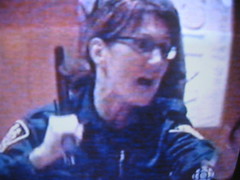

Sergeant Parks managed to grab a young protestor when he entered a room off the washroom hallway.
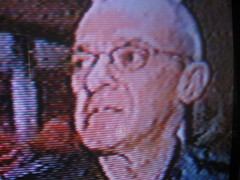
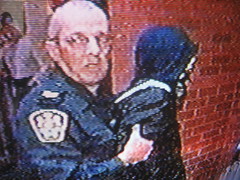
He was placed under arrest and handcuffed by the officer. In the meantime Constable Lawlor and Constable Cooper were trying to survive the onslaught and at the same time protect the public and the Center from damage.
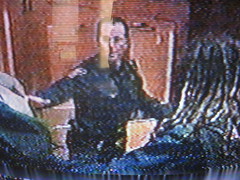
There is no question that the officers feared for their own safety……but courageously stood between the howling mob and the now locked glass doors to the meeting room. Constable Lawlor feared that they would be pushed through the glass doors by the weight of the surging mob. The officers held their ground, called for help and waited for other officers to arrive, while holding back the mob of 30-40 people. Fortunately the City Police had prepared for this possibility, having briefed the general duty officers working on this day, and within minutes, almost every officer on duty in the city had arrived at the Center. A powerful line of police officers was soon in place and the protestors were moved away from the doors with apparently little resistance.
The evidence reveals that the defendant had been in the public foyer of the Trade and Convention Center during the morning of June 9th. In fact, Constable Lawlor’s attention was directed towards Mr. LeBlanc because he appeared to be on a first name basis with some of the delegates. He was taking pictures with his small digital camera in the public foyer area outside the cordoned off area. He was there on and off throughout the morning.
Sometime during the morning a group of protestors arrived. They caused no trouble and left shortly after they had arrived. There was no evidence to suggest the defendant was in any way connected with the demonstrators.
When the protestors arrived in force around 1:00 p.m. there was no evidence the defendant was with them, in fact I’m satisfied he was not. He was, however, in the foyer when all hell was breaking loose and the barricades had come down. There was now a completely open space in front of the entrance to the meeting room. It was within this open space that Mr. LeBlanc was taking pictures for his blog. He was arrested by Sergeant Parks a short time later after the police reinforcements appeared to have the situation under control.
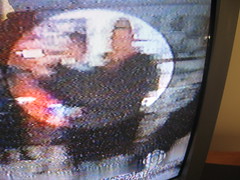
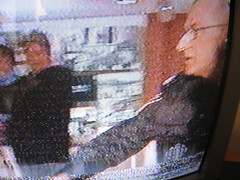
During Mr. LeBlanc’s arrest and handcuffing, while on the floor, his camera was removed from his hand to more easily allow the police to lock the handcuffs.
Constable McCaig was clearly responsible for the removal of the camera, and the strap which encircled Mr. LeBlanc’s wrist.
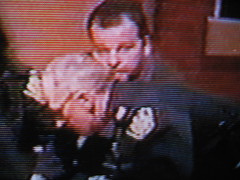
In his initial testimony, Constable McCaig made no mention of the camera. Upon returning to the witness stand after the C.B.C. video was played, Constable McCaig explained that until he saw it on the video, he had no recollection of removing the camera from Mr. LeBlanc. He did not hold onto the camera…….simply removed it to assist in the handcuffing and then left it on the floor. I find no problem with his actions.
Mr. LeBlanc’s camera was picked up by Sergeant Parks, who held onto it and transported it to the police station where Mr. LeBlanc was being held. Sergeant Parks took it upon himself to turn the camera on and upon seeing a picture of himself on the camera, deleted it. He testified that he was very uncomfortable seeing his picture on Mr. LeBlanc’s camera and that was why he deleted it. On cross examination it was suggested that Sergeant Parks had deleted all of the pictures on the camera, but he denied it. Suffice to say, from a personal standpoint I can understand Sergeant Parks’ actions in deleting the picture. From a legal standpoint however it is unacceptable. The camera was never seized as evidence……..legal access to the contents of the camera would be permitted only through a search warrant. No warrant was ever obtained by Sergeant Parks, so he had no legal right to erase a picture from Mr. LeBlanc’s camera.
THE LAW
Turning my attention to the law as it relates specifically to the charge of willfully obstructing a peace officer in the execution of his duty, it is clear that to be successful the crown must prove the following, beyond a reasonable doubt:
(1) the actions of the defendant were willful;
(2) these actions amounted to an obstruction;
(3) the officer was acting in the execution of
his duty………that is, he must not be exceeding the
powers given to him by statute or common law;
The word willful, in legal terms, connotes an intention to bring about the proscribed consequence. It implies that the defendant knew what he was doing and intended to do what he did, i.e. obstruct Sergeant Parks.
The obstruction in this case would be that the defendant willfully refused to leave when, and, in this case, if, Sergeant Parks ordered him to do so.
Considering the third element of the charge, there is a considerable body of law. I would like to deal with it in some detail as this prosecution centers around the common law powers enjoyed by the police to preserve the peace as it relates to the protection of life and property.
The common law right has long been recognized by the courts in this country. The accepted test for evaluating the common law powers and duties of the police was set out many years ago in the English case of R. v. Waterfield, [1963] 3 All E.R. 659 (C.C.A.). The so called Waterfield test has been adopted with approval over the years by numerous Provincial Courts of Appeal, as well as the Supreme Court of Canada. As recently as 1999, in the case of R. v. Goday, 1999 CanLII 709 (S.C.C.), [1999] 1 S.C.R. 311, Chief Justice Lamer adopted the reasoning in Waterfield as the accepted test for evaluating the common law powers and duties of the police when he said;
“If police conduct constitutes a prima facie interference with a person’s liberty or property, the court must consider two questions: first, does the conduct fall within the scope of any duty imposed by the statute, or recognized at common law; and second, does the conduct albeit within the general scope of such a duty involve an unjustifiable use of powers associated with the duty.”
In reaching my decision in this case, I found the 1973 Supreme Court decision of Knowlton v. the Queen (1973), 10 C.C.C. (2d) 513 to be helpful. The fact situation in that case is somewhat similar to the present case. Briefly stated, the facts in Knowlton are as follows:
After visiting Ottawa a few days before, and having been the victim of an assault, Russian Premier Kosygin was to visit Edmonton, Alberta on October 24th, 1971. Sergeant Grandish of the Edmonton City Police Force was assigned to provide security for the Premier while he paid a short visit to the Chateau Lacombe Hotel. For this purpose, and with the assistance of 25 police officers, Sergeant Grandish cordoned off an area in front of the entrance to the hotel which included part of the sidewalk. Immediately prior to the arrival of the Russian Premier, the Sergeant was summoned by 2 officers who were posted in the area of the cordoned off sidewalk. Upon arrival he met Mr. Knowlton, who insisted that he be allowed to take photographs from within the cordoned off area. Sergeant Grandish told Mr. Knowlton he would be arrested if he did so. Ignoring the sergeants warning, he entered the restricted area and was arrested, and charged with obstruction. Two levels of court found him not guilty, while the Supreme Court overturned those decisions and found him guilty.
The Supreme Court adopted the two part Waterfield test and found that the first parts of the test had been met because the officers were statutorily empowered to preserve the peace, order and public safety. Considering that they were dealing with a Head of State who sadly had been assaulted in the nations capital only a few days before, the court found not only did the police have the authority to do what they did, but in fact had a duty to do so.
As to the second part of the test, the Supreme Court found there was no unjustifiable use of the powers associated with the duty imposed upon the police officers. This, in spite of the fact that the police did not inform Mr. Knowlton of any legal justification for the interferences with his right to free access to public streets…..In that regard, the Supreme Court justices placed considerable weight on the fact that Mr. Knowlton was aware that the Russian Premier had been assaulted in Ottawa and so would be aware of the duty of the Edmonton Police to ensure the security of Premier Kosygin at some cost to public freedoms. Also the fact the Mr. Knowlton could have applied for a press pass which would have granted him access to the cordoned off area, but chose not to do so, weighed heavily against the claim that the police used measures which were unjustifiable against him in carrying out their duty to protect the Russian Premier.
Comparing the Crown’s case against Mr. LeBlanc and the Knowlton case there are obvious differences which militate in Mr. LeBlanc’s favor.
Mr. LeBlanc was never advised by the police that he would be arrested if he did certain things – He was simply plying his trade, photographing a demonstration for inclusion in his blog when he was arrested.
Unlike the Knowlton case, there was no clearly marked area where the pubic was not permitted at the time of Mr. LeBlanc’s arrest…….barricades that had been in place earlier in the day, had been destroyed by the protestors. There was no suggestion that Mr. LeBlanc was involved in this. For all intents and purposes, Mr. LeBlanc was ostensibly in an area accessible to, and in fact, open to the public when he was taking his photographs. Members of the so called main stream media were taking photographs and filming in the same area without interference from the police. I believe it’s fair to say that the defendant was doing nothing wrong at the time he was approached by Sergeant Parks and placed under arrest. He was simply plying his trade……gathering photographs and information for his blog along side other reporters.
Why Sergeant Parks singled him out, I can only speculate. It is clear from the C.B.C. video that contrary to what Sergeant Parks testified to, Mr. LeBlanc was off to his right some distance, not behind him. It’s likewise clear when reviewing the tape in slow motion, that contrary to what Sergeant Parks testified to, the defendant was not moving towards him just prior to his arrest. It is inconceivable to me after viewing the tape, how Sergeant Parks could have perceived the defendant, down on one knee, some distance from the protestors, taking pictures, as a threat. Other people were in the immediate area of the defendant, some taking pictures and at least one of whom was a masked protestor, who was not even approached by the police.
It is clear from the video that immediately upon turning the previously arrested Mr. Webber over to another officer, Sergeant Parks for some reason, went directly towards the defendant, grabbed him in the upper chest area, pushed him towards the far wall, and pinned him there. In his testimony, Sergeant Parks said that he did not touch the defendant until they were at the far wall. Sergeant Parks justified his arrest of the defendant, not only on the basis that the defendant was behind him and that he posed a threat with his camera, and that he was moving towards him, but also because he refused a direct order from Sergeant Parks to leave the area.
After viewing the video many times at normal speed and slow speed, the conversation the officer said he had with Mr. LeBlanc prior to his arrest was not in any way apparent to me. Perhaps that would explain why Mr. LeBlanc kept yelling and questioning the officers as to why he had been arrested and what he had done wrong, as Sergeant Parks and two officers were kneeling on top of him applying handcuffs.
Sergeant Parks said the defendant was resisting somewhat and had to be taken to the floor in order to apply handcuffs, yet the photo marked Exhibit “D” clearly shows Sergeant Parks and Mr. LeBlanc strolling arm and arm from one side of the foyer to the other with no sign whatsoever of resistance from the defendant.
It is an important factor as well that at the time Sergeant Parks quickly moved towards Mr. LeBlanc and grabbed him, pushed him some distance to the wall and pinned him there, the police were there in numbers and had the situation apparently under control. None of the protestors that I saw in the video were attempting to cross the police line. They were just taunting and yelling loudly at the police officers. They did not appear to be posing a threat to the police or the public at the time of Mr. LeBlanc’s arrest. The police who had formed a solid line between the protestors and the glass doors to the center were very cool, calm and collected and behaved in a very professional manner. I mention this because it further enforces my belief that at that time, there was no apparent reason to arrest Mr. LeBlanc.
It may well be asked if Mr. LeBlanc’s chosen occupation as a blogger had any bearing on my decision in this case. The answer to that is yes and no. The fact that the defendant was a blogger explained why he was at the Trade and Convention Center taking pictures, while a riot was going on. It could also explain why he was on a first name basis with some of the delegates. It would explain why he was so upset at being arrested, as he obviously considered himself to be a legitimate member of the media who had done nothing wrong.
Assuming for the purposes of my decision that Mr. LeBlanc was a legitimate member of the media, did this grant him any special exemption from following the directions of the police? The answer to that is clearly no. Provided the police are acting in the execution of their duties and not exceeding their common law powers, Mr. LeBlanc and any other member of a so called mainstream news organization would be obligated to follow the instructions of a police officer, again provided the officer was acting within the scope of his authority. Members of the media are no different from any other citizen in this regard. A legitimate order from a police officer must be followed by every citizen. If I were satisfied beyond a reasonable doubt that Sergeant Parks was acting within his authority and had not exceeded his common law powers when, and if, he ordered the defendant to leave the Trade and Convention Center, the result in this case would have been different.
The onus on the Crown is a heavy one. The defendant is presumed innocent. The Crown must prove its case beyond a reasonable doubt. The defendant has to prove nothing.
The conflicting evidence in this case presents me with difficulties in arriving at a conclusion the accused is guilty as charged. There is such a discrepancy between the evidence of Sergeant Parks and the CBC video, that I find it unsafe to convict Mr. LeBlanc. I am not even satisfied beyond a reasonable doubt that if Mr. LeBlanc was in fact ordered to leave by Sergeant Parks, he heard or understood the order. I have pointed out other serious inconsistencies between the evidence of Sergeant Parks and the video earlier on in this judgment. Considering the evidence in it’s totality with all of the inconsistencies, I am not satisfied beyond a reasonable doubt that Charles LeBlanc willfully obstructed Sergeant Parks in the execution of his duty.
Having come to this conclusion, it is not necessary for me to consider the Stay of Proceedings Order requested by the defence in it’s pre-trial document on the basis of Charter of Rights violations. Needless to say, the issues of arbitrary arrest and the unwarranted destruction of evidence on the defendant’s camera would have weighed heavily in favour of a Stay of Proceedings.
In conclusion I wish to say this; it is very easy in the cool, clear, light of day for this court to calmly and coolly analyze and make decisions about the actions of police officers who were making split second decisions in the heat of the moment. But this is what the court is obliged to do. In spite of my findings in this case, there is one conclusion I have come to beyond any doubt. These courageous officers acted above and beyond the call of duty in preventing a serious breach of the peace. If these young masked invaders had succeeded in gaining access to the main meeting room where probably hundreds of delegates were in attendance, God knows what would have happened.
William J. McCarroll
Judge, Provincial Court of New Brunswick
This document: 2006 NBPC 37 (CanLII)
Citation: R. v. LeBlanc, 2006 NBPC 37 (CanLII)
Date: 2006-11-24
Docket: 05571102
[Noteup] [Cited Decisions and Legislation]
Citation #2006NBPC37
IN THE PROVINCIAL COURT OF NEW BRUNSWICK
JUDICIAL DISTRICT OF SAINT JOHN
Date: November 24th, 2006 Docket: 05571102
Between:
Her Majesty The Queen
- and –
Charles Joseph LeBlanc
Before: Judge William McCarroll

Date of Hearing: November 2nd, 20th, 21st, 2006
Date of Decision: November 24th, 2006
Appearances:
Catherine McNally - Agent for the Crown
Harold Doherty - Agent for the Defendant
McCARROLL, Prov. Ct. J.
Police work is difficult on the best of days. June 9th, 2006 was not a good day. To say that all hell broke loose for a few terrifying moments at the Trade and Convention Center on that day would not do justice to the situation. No amount of training could have prepared three of Saint John’s finest, standing at the entrance to the meeting rooms of the Center, for the onslaught of masked and noisy demonstrators racing towards them with sticks and signs, intent on pushing their way through the glass doors to the interior of the conference hall. Only the strength and courage of the three officers who stood up to the onslaught prevented a more serious situation from developing inside the meeting room. These officers are to be commended for their courage and determination.
Caught up in the middle of all of this was the defendant, Charles LeBlanc. There was no evidence whatsoever that he was in any way involved with the group of protestors. Mr. LeBlanc is a “blogger”. I’m sure that many, if not the majority of Saint Johners, are not familiar with this word. This is not surprising, since the word, to my knowledge has not yet found its way into a dictionary. I went to the computer in an attempt to find a definition.
The Google website defines “blogger” as a person who writes weblogs, and a blog as a shortened version of weblog.
I reprinted the following definitions from the Google website:
“Blog is short for weblog. A weblog is a journal (or newsletter) that is frequently updated and intended for general public consumption. Blogs generally represent the personality of the author on the web site.”
“A blog is basically a journal that is available on the web. The activity of updating a blog is “blogging” and someone who keeps a blog is a “blogger”. Blogs are typically updated daily using software that allows people with little or no technical background to update and maintain the blog.”
“A “web log” or online diary. Blogs have been identified as an increasingly popular source of online publication, especially regarding political information, opinion publication and alternative news coverage.”
“A collaborative space either stand alone or within a website that visitors can post comments, link to, add to, or just read on a weekly, daily, hourly basis. Used extensively on journalism sites for breaking news, etc……”
Apparently the defendant is quite well known for his blog. In fact, Sergeant Connell, the police security planner, utilized the information obtained on the defendant’s blog to gather intelligence about the potential for protest during the Atlantica conference. Sergeant Connell did not expect that Mr. LeBlanc would himself cause any problems at the conference.
However, on June 9th, 2006 while Mr. LeBlanc was taking photographs of the demonstration at the Trade and Convention Center, he was arrested for willfully obstructing Sergeant John Parks.

The Facts
On June 9th, 2006, the Saint John Trade and Convention Center played host to the “Atlantica” Conference. Delegates were in attendance from the Atlantic Provinces and the New England States.
Because of the nature of the business being discussed, organizers feared the arrival of protestors, and took precautions to prevent a breach of the peace. Two police officers were assigned to attend at the Convention Center on each day of the meetings. These officers received their orders directly from senior police officers within the Saint John Police Department, and were at all times acting in the capacity of on duty officers, whose main assignment was to keep the peace, protect the public and property.
On June 9th, 2006 Sergeant John Parks and Constable Tanya Lawlor arrived at the Center at 7:00 a.m. They took up positions in the area of the glass doors leading into the meeting room.
Organizers of the conference had taken great pains to ensure that the expected protestors would not disrupt proceedings. The foyer of the Center had been cordoned off on both sides with metal posts and drapery. Entry to the meeting room was to be through a rather narrow space between the two cordoned off areas. It was made clear to delegates that name tags were required at all times in order to gain entry to the meeting room. Even paid up delegates were turned away if they were not in possession of their name tags. The hallway entrance to the washrooms was behind the cordoned off area, so that only delegates with name tags could access the washrooms.
On the far end of the hallway leading to the washrooms was the business office of the Center. An emergency door was at the end of this hallway. It was locked from inside, leaving the only entrance point to the meeting room the space between the cordoned off areas.
Between 12:30 and 1:00 p.m. on June 9th, a younger looking man wearing a name tag came from inside the meeting room, and headed down the hallway in the direction of the washrooms. Within minutes there was a howling mass of masked and unmasked young people running through the same hallway toward the glass doors of the Center. They were yelling, banging things, carrying signs and were clearly intent on gaining access to the meeting room.

Only 3 police officers stood between this howling mass of humanity and the glass doors into the Center. The third officer, Constable Cooper had only arrived seconds before to see if either Sergeant Parks or Constable Lawlor wanted to take a short break. It was fortunate that he was there.


As the mob approached the cordoned off area, the poles and draperies quickly came crashing to the floor…..now there was no cordoned off area. Many of the female organizers of the event ran into the rooms and locked the doors…..they were terrified…..but who wouldn’t have been.


Sergeant Parks managed to grab a young protestor when he entered a room off the washroom hallway.


He was placed under arrest and handcuffed by the officer. In the meantime Constable Lawlor and Constable Cooper were trying to survive the onslaught and at the same time protect the public and the Center from damage.

There is no question that the officers feared for their own safety……but courageously stood between the howling mob and the now locked glass doors to the meeting room. Constable Lawlor feared that they would be pushed through the glass doors by the weight of the surging mob. The officers held their ground, called for help and waited for other officers to arrive, while holding back the mob of 30-40 people. Fortunately the City Police had prepared for this possibility, having briefed the general duty officers working on this day, and within minutes, almost every officer on duty in the city had arrived at the Center. A powerful line of police officers was soon in place and the protestors were moved away from the doors with apparently little resistance.
The evidence reveals that the defendant had been in the public foyer of the Trade and Convention Center during the morning of June 9th. In fact, Constable Lawlor’s attention was directed towards Mr. LeBlanc because he appeared to be on a first name basis with some of the delegates. He was taking pictures with his small digital camera in the public foyer area outside the cordoned off area. He was there on and off throughout the morning.
Sometime during the morning a group of protestors arrived. They caused no trouble and left shortly after they had arrived. There was no evidence to suggest the defendant was in any way connected with the demonstrators.
When the protestors arrived in force around 1:00 p.m. there was no evidence the defendant was with them, in fact I’m satisfied he was not. He was, however, in the foyer when all hell was breaking loose and the barricades had come down. There was now a completely open space in front of the entrance to the meeting room. It was within this open space that Mr. LeBlanc was taking pictures for his blog. He was arrested by Sergeant Parks a short time later after the police reinforcements appeared to have the situation under control.


During Mr. LeBlanc’s arrest and handcuffing, while on the floor, his camera was removed from his hand to more easily allow the police to lock the handcuffs.
Constable McCaig was clearly responsible for the removal of the camera, and the strap which encircled Mr. LeBlanc’s wrist.

In his initial testimony, Constable McCaig made no mention of the camera. Upon returning to the witness stand after the C.B.C. video was played, Constable McCaig explained that until he saw it on the video, he had no recollection of removing the camera from Mr. LeBlanc. He did not hold onto the camera…….simply removed it to assist in the handcuffing and then left it on the floor. I find no problem with his actions.
Mr. LeBlanc’s camera was picked up by Sergeant Parks, who held onto it and transported it to the police station where Mr. LeBlanc was being held. Sergeant Parks took it upon himself to turn the camera on and upon seeing a picture of himself on the camera, deleted it. He testified that he was very uncomfortable seeing his picture on Mr. LeBlanc’s camera and that was why he deleted it. On cross examination it was suggested that Sergeant Parks had deleted all of the pictures on the camera, but he denied it. Suffice to say, from a personal standpoint I can understand Sergeant Parks’ actions in deleting the picture. From a legal standpoint however it is unacceptable. The camera was never seized as evidence……..legal access to the contents of the camera would be permitted only through a search warrant. No warrant was ever obtained by Sergeant Parks, so he had no legal right to erase a picture from Mr. LeBlanc’s camera.
THE LAW
Turning my attention to the law as it relates specifically to the charge of willfully obstructing a peace officer in the execution of his duty, it is clear that to be successful the crown must prove the following, beyond a reasonable doubt:
(1) the actions of the defendant were willful;
(2) these actions amounted to an obstruction;
(3) the officer was acting in the execution of
his duty………that is, he must not be exceeding the
powers given to him by statute or common law;
The word willful, in legal terms, connotes an intention to bring about the proscribed consequence. It implies that the defendant knew what he was doing and intended to do what he did, i.e. obstruct Sergeant Parks.
The obstruction in this case would be that the defendant willfully refused to leave when, and, in this case, if, Sergeant Parks ordered him to do so.
Considering the third element of the charge, there is a considerable body of law. I would like to deal with it in some detail as this prosecution centers around the common law powers enjoyed by the police to preserve the peace as it relates to the protection of life and property.
The common law right has long been recognized by the courts in this country. The accepted test for evaluating the common law powers and duties of the police was set out many years ago in the English case of R. v. Waterfield, [1963] 3 All E.R. 659 (C.C.A.). The so called Waterfield test has been adopted with approval over the years by numerous Provincial Courts of Appeal, as well as the Supreme Court of Canada. As recently as 1999, in the case of R. v. Goday, 1999 CanLII 709 (S.C.C.), [1999] 1 S.C.R. 311, Chief Justice Lamer adopted the reasoning in Waterfield as the accepted test for evaluating the common law powers and duties of the police when he said;
“If police conduct constitutes a prima facie interference with a person’s liberty or property, the court must consider two questions: first, does the conduct fall within the scope of any duty imposed by the statute, or recognized at common law; and second, does the conduct albeit within the general scope of such a duty involve an unjustifiable use of powers associated with the duty.”
In reaching my decision in this case, I found the 1973 Supreme Court decision of Knowlton v. the Queen (1973), 10 C.C.C. (2d) 513 to be helpful. The fact situation in that case is somewhat similar to the present case. Briefly stated, the facts in Knowlton are as follows:
After visiting Ottawa a few days before, and having been the victim of an assault, Russian Premier Kosygin was to visit Edmonton, Alberta on October 24th, 1971. Sergeant Grandish of the Edmonton City Police Force was assigned to provide security for the Premier while he paid a short visit to the Chateau Lacombe Hotel. For this purpose, and with the assistance of 25 police officers, Sergeant Grandish cordoned off an area in front of the entrance to the hotel which included part of the sidewalk. Immediately prior to the arrival of the Russian Premier, the Sergeant was summoned by 2 officers who were posted in the area of the cordoned off sidewalk. Upon arrival he met Mr. Knowlton, who insisted that he be allowed to take photographs from within the cordoned off area. Sergeant Grandish told Mr. Knowlton he would be arrested if he did so. Ignoring the sergeants warning, he entered the restricted area and was arrested, and charged with obstruction. Two levels of court found him not guilty, while the Supreme Court overturned those decisions and found him guilty.
The Supreme Court adopted the two part Waterfield test and found that the first parts of the test had been met because the officers were statutorily empowered to preserve the peace, order and public safety. Considering that they were dealing with a Head of State who sadly had been assaulted in the nations capital only a few days before, the court found not only did the police have the authority to do what they did, but in fact had a duty to do so.
As to the second part of the test, the Supreme Court found there was no unjustifiable use of the powers associated with the duty imposed upon the police officers. This, in spite of the fact that the police did not inform Mr. Knowlton of any legal justification for the interferences with his right to free access to public streets…..In that regard, the Supreme Court justices placed considerable weight on the fact that Mr. Knowlton was aware that the Russian Premier had been assaulted in Ottawa and so would be aware of the duty of the Edmonton Police to ensure the security of Premier Kosygin at some cost to public freedoms. Also the fact the Mr. Knowlton could have applied for a press pass which would have granted him access to the cordoned off area, but chose not to do so, weighed heavily against the claim that the police used measures which were unjustifiable against him in carrying out their duty to protect the Russian Premier.
Comparing the Crown’s case against Mr. LeBlanc and the Knowlton case there are obvious differences which militate in Mr. LeBlanc’s favor.
Mr. LeBlanc was never advised by the police that he would be arrested if he did certain things – He was simply plying his trade, photographing a demonstration for inclusion in his blog when he was arrested.
Unlike the Knowlton case, there was no clearly marked area where the pubic was not permitted at the time of Mr. LeBlanc’s arrest…….barricades that had been in place earlier in the day, had been destroyed by the protestors. There was no suggestion that Mr. LeBlanc was involved in this. For all intents and purposes, Mr. LeBlanc was ostensibly in an area accessible to, and in fact, open to the public when he was taking his photographs. Members of the so called main stream media were taking photographs and filming in the same area without interference from the police. I believe it’s fair to say that the defendant was doing nothing wrong at the time he was approached by Sergeant Parks and placed under arrest. He was simply plying his trade……gathering photographs and information for his blog along side other reporters.
Why Sergeant Parks singled him out, I can only speculate. It is clear from the C.B.C. video that contrary to what Sergeant Parks testified to, Mr. LeBlanc was off to his right some distance, not behind him. It’s likewise clear when reviewing the tape in slow motion, that contrary to what Sergeant Parks testified to, the defendant was not moving towards him just prior to his arrest. It is inconceivable to me after viewing the tape, how Sergeant Parks could have perceived the defendant, down on one knee, some distance from the protestors, taking pictures, as a threat. Other people were in the immediate area of the defendant, some taking pictures and at least one of whom was a masked protestor, who was not even approached by the police.
It is clear from the video that immediately upon turning the previously arrested Mr. Webber over to another officer, Sergeant Parks for some reason, went directly towards the defendant, grabbed him in the upper chest area, pushed him towards the far wall, and pinned him there. In his testimony, Sergeant Parks said that he did not touch the defendant until they were at the far wall. Sergeant Parks justified his arrest of the defendant, not only on the basis that the defendant was behind him and that he posed a threat with his camera, and that he was moving towards him, but also because he refused a direct order from Sergeant Parks to leave the area.
After viewing the video many times at normal speed and slow speed, the conversation the officer said he had with Mr. LeBlanc prior to his arrest was not in any way apparent to me. Perhaps that would explain why Mr. LeBlanc kept yelling and questioning the officers as to why he had been arrested and what he had done wrong, as Sergeant Parks and two officers were kneeling on top of him applying handcuffs.
Sergeant Parks said the defendant was resisting somewhat and had to be taken to the floor in order to apply handcuffs, yet the photo marked Exhibit “D” clearly shows Sergeant Parks and Mr. LeBlanc strolling arm and arm from one side of the foyer to the other with no sign whatsoever of resistance from the defendant.
It is an important factor as well that at the time Sergeant Parks quickly moved towards Mr. LeBlanc and grabbed him, pushed him some distance to the wall and pinned him there, the police were there in numbers and had the situation apparently under control. None of the protestors that I saw in the video were attempting to cross the police line. They were just taunting and yelling loudly at the police officers. They did not appear to be posing a threat to the police or the public at the time of Mr. LeBlanc’s arrest. The police who had formed a solid line between the protestors and the glass doors to the center were very cool, calm and collected and behaved in a very professional manner. I mention this because it further enforces my belief that at that time, there was no apparent reason to arrest Mr. LeBlanc.
It may well be asked if Mr. LeBlanc’s chosen occupation as a blogger had any bearing on my decision in this case. The answer to that is yes and no. The fact that the defendant was a blogger explained why he was at the Trade and Convention Center taking pictures, while a riot was going on. It could also explain why he was on a first name basis with some of the delegates. It would explain why he was so upset at being arrested, as he obviously considered himself to be a legitimate member of the media who had done nothing wrong.
Assuming for the purposes of my decision that Mr. LeBlanc was a legitimate member of the media, did this grant him any special exemption from following the directions of the police? The answer to that is clearly no. Provided the police are acting in the execution of their duties and not exceeding their common law powers, Mr. LeBlanc and any other member of a so called mainstream news organization would be obligated to follow the instructions of a police officer, again provided the officer was acting within the scope of his authority. Members of the media are no different from any other citizen in this regard. A legitimate order from a police officer must be followed by every citizen. If I were satisfied beyond a reasonable doubt that Sergeant Parks was acting within his authority and had not exceeded his common law powers when, and if, he ordered the defendant to leave the Trade and Convention Center, the result in this case would have been different.
The onus on the Crown is a heavy one. The defendant is presumed innocent. The Crown must prove its case beyond a reasonable doubt. The defendant has to prove nothing.
The conflicting evidence in this case presents me with difficulties in arriving at a conclusion the accused is guilty as charged. There is such a discrepancy between the evidence of Sergeant Parks and the CBC video, that I find it unsafe to convict Mr. LeBlanc. I am not even satisfied beyond a reasonable doubt that if Mr. LeBlanc was in fact ordered to leave by Sergeant Parks, he heard or understood the order. I have pointed out other serious inconsistencies between the evidence of Sergeant Parks and the video earlier on in this judgment. Considering the evidence in it’s totality with all of the inconsistencies, I am not satisfied beyond a reasonable doubt that Charles LeBlanc willfully obstructed Sergeant Parks in the execution of his duty.
Having come to this conclusion, it is not necessary for me to consider the Stay of Proceedings Order requested by the defence in it’s pre-trial document on the basis of Charter of Rights violations. Needless to say, the issues of arbitrary arrest and the unwarranted destruction of evidence on the defendant’s camera would have weighed heavily in favour of a Stay of Proceedings.
In conclusion I wish to say this; it is very easy in the cool, clear, light of day for this court to calmly and coolly analyze and make decisions about the actions of police officers who were making split second decisions in the heat of the moment. But this is what the court is obliged to do. In spite of my findings in this case, there is one conclusion I have come to beyond any doubt. These courageous officers acted above and beyond the call of duty in preventing a serious breach of the peace. If these young masked invaders had succeeded in gaining access to the main meeting room where probably hundreds of delegates were in attendance, God knows what would have happened.
William J. McCarroll
Judge, Provincial Court of New Brunswick
Subscribe to:
Comments (Atom)
